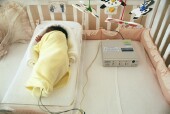
FRIDAY, Feb. 24 (HealthDay News) — Sudden Infant Death Syndrome (SIDS) may sometimes have a genetic component, a team of German researchers reports.
DNA analysis from a small group of infants who succumbed to SIDS revealed that many of the male children carried a particular enzyme mutation that may have impaired their ability to breath properly. This was not the case for female SIDS patients.
Study author Dr. Michael Klintschar, director of the Institute for Legal Medicine at Medical University Hannover in Germany, said his team tried to build upon previous research suggesting that “abnormalities in the brain stem, the part of the brain that regulates breathing and other basic functions, lead to SIDS.”
“The reasons for these abnormalities are unclear,” he noted, “but some scientists believe that the genes inherited by the parents might be one of several factors.”
Klintschar and his colleagues found indications that SIDS risk might be higher among male infants who carry a mutation of an enzyme — called MAOA — that appears to impede key neurotransmitter function.
“Babies that have this variant inherited might have an impaired breathing regulation,” he said. “But the risk conveyed by this gene variant is relatively small compared to other factors, like sleeping position [or exposure to] smoking. Moreover, the findings have to be replicated in another population sample.”
The study appears online and in the March issue of Pediatrics.
The authors noted that SIDS is one of the great mysteries in pediatric medicine, with efforts to pin down the root cause for the sudden loss of children under the age of 1 year falling short of a definitive answer.
The new study focused on 156 white infants (99 boys and 57 girls) who were born in the Lower Saxony region of Germany and died while sleeping.
The deaths took place between the second and the 51st week of life, and all remained “unexplained” despite full autopsies, clinical history reviews and analyses of the circumstances of death.
DNA samples were taken from all the deceased, as well as from another 260 male adults between the ages of 18 and 30.
The result: MAOA mutations were more commonly found among male SIDS children than among their healthy male counterparts. This did not hold true with female SIDS children.
Most mutations appeared to be clustered within a specific time frame of death that correlated with the majority of SIDS fatalities. That is, infants who had died between the age of 46 days and 154 days — the most prevalent period of SIDS deaths among the study group — were significantly more likely to carry MAOA mutations than those children who died at ages above 5 months.
The authors concluded that among at least a subset of male SIDS patients, a genetic brain stem abnormality might be the driving force leading to their sudden loss.
“Our study furthers our understanding of the mechanism of SIDS,” Klintschar said. “[But] it does not lead directly to a ‘cure’ of SIDS. And up to now [it] does not enable a lab test to estimate the individual risk of a baby to die from SIDS. But it emphasizes that measures already recommended to prevent SIDS — using pacifiers, avoid sleeping in the prone position, no smoking during pregnancy — make sense. Mothers of families with a prior SIDS case in the family should be more careful than others. But in most cases, obeying these recommendations keeps the baby safe.”
However, while also an advocate of such basic preventive measures, Dr. Warren Guntheroth, a professor of pediatrics at the University of Washington School of Medicine in Seattle, holds no stock in a genetic basis for SIDS.
“I think it’s nonsense,” he said. “There’s years and years of research that has shown that SIDS is not inherited. Not genetic. The only genetic link I will admit to is that males are definitely more at risk than females. But apart from that, I think fooling around with laboratory studies of genes and saying that that might cause SIDS is a far reach.”
So what can parents do?
“Probably one of the most important things is not to put the baby on its tummy for sleep. That reduces risk by 50 percent,” Guntheroth said. “Another is the use of the pacifier. Pacifiers, for reasons nobody understands well, reduces the risk. Also, don’t overheat the child, by overdressing or putting the infant in a room that is too hot. Finally, cigarettes increase the risk terribly. Living with a parent that smokes is a definite risk factor, so the parent can do themselves and the child a favor by quitting or at least not smoking in the same area as the child.”
More information
For more on SIDS, visit the U.S. National Library of Medicine.

